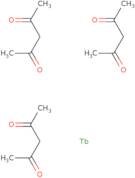Terbium(III) acetylacetonate
CAS: 14284-95-8
Ref. 3D-PAA28495
| 5g | Discontinued | ||
| 10g | Discontinued | ||
| 25g | Discontinued | ||
| 50g | Discontinued | ||
| 100g | Discontinued |
Product Information
- (OC-6-11)-Tris(2,4-pentanedionato-κO<sup>2</sup>,κO<sup>4</sup>)terbium
- NSC 139615
- Pentane-2,4-Dione - Terbium (3:1)
- Terbium (III) acetylacetonate
- Terbium acetylacetonate
- Terbium(3+) Tris(4-Oxopent-2-En-2-Olate)
- Terbium, tris(2,4-pentanedionato)-
- Terbium, tris(2,4-pentanedionato-O,O)-, (OC-6-11)-
- Terbium, tris(2,4-pentanedionato-κO,κO′)-, (OC-6-11)-
- Terbium, tris(2,4-pentanedionato-κO<sup>2</sup>,κO<sup>4</sup>)-, (OC-6-11)-
- See more synonyms
- Terbiumacetylacetonate
- Terbiumacetylacetonatetrihydrate
- Tris(2,4-pentanedionato)terbium
- Tris(acetylacetonato)terbium
- Tris(acetylacetonato)terbium(III)
- Terbium, tris(2,4-pentanedionato-κO2,κO4)-, (OC-6-11)-
- (OC-6-11)-Tris(2,4-pentanedionato-κO2,κO4)terbium
Terbium(III) acetylacetonate (TEA) is an organic compound that has been used as a luminescent agent for optical applications. It emits light upon irradiation with ultraviolet light or with visible light in the presence of an activator. TEA shows a low efficiency, which is attributed to its inability to emit fluorescence at room temperature. The reaction mechanism for this compound is not yet well understood, and it appears to be an example of a metal chelate. TEA can also react with silicon, forming terbium silicide (TBSi). The hydrocarbon group has been shown to be reactive.





